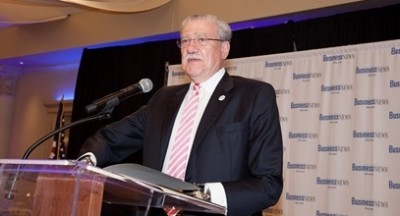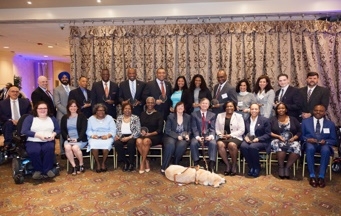Diversity awards also shine spotlight on disability
http://libn.com/2017/04/27/diversity-awards-also-shine-spotlight-on-disability/ (ขนาดไฟล์: 14733)
John Kemp, CEO of The Viscardi Center, arrived at Long Island Business News’ Diversity in Business Awards well dressed and wearing a tie like many others. It’s unlikely that most people would think about diversity as having much to do with how one dresses – although a veil or a turban might come to mind for some.
But Kemp, who has prosthetic arms, dresses himself through a process very different than others, handling everything from buttoning his shirt to putting on a tie in a way that itself amounts to addressing a challenge.
He spoke at Long Island Business News’ Diversity in Business Awards April 25 at the Crest Hollow Country Club after they were expanded to include people with disabilities, following his request to get the publication to recognize those as a minority in their own right.
“We do things differently, but there’s the richness of diversity in a microcosm,” Kemp, the keynote speaker at the awards said after describing his own process to do something as simple to others as dressing in the morning. “There are lots of different ways of getting to the same end.”
Diversity is strength, he argued and the awards showcased, and companies with a diverse work force, in terms of race, age, sexual orientation, gender and nation of origin typically can proudly point to that fact. The awards ceremony showcased a wide range of success stories, exemplary people from private industry to government.
“A diverse workforce can capture a greater share of consumer market,” Kemp said. “Your workforce should mirror your consumers and even your suppliers.”
While diversity is often seen as strength, Kemp, however, argued that we need to broaden our definition to include people with other differences, such as disabilities, often highly competent, intelligent and skilled despite prejudices that may ignore those strengths.
“You’ve got to think about how to accommodate aging workers,” Kemp said, noting an aging workforce is leading to more disabilities. “They have a lot of experience.”
Kemp championed a different, even broader view of diversity than many have, making the point that the disabled are sometimes unfairly defined by their physical differences rather than by their other strengths, perceived sometimes through the twin lenses of pity and prejudice.
“Being a member of the disability community has become commonplace and, maybe, even trendy,” he said before joking. “Think of all the people trying to park in our disability parking spaces on a rainy day when we really need it.”
Kemp added that as people live longer, disabilities become more common, making the disabled a bigger demographic and more powerful minority – as consumers and workers. “The number of people with disabilities is skyrocketing compared with the growth rate of the general population,” Kemp continued.
Kemp earlier in a letter to the editor at LIBN had urged the publication to include those with disabilities as a minority in the event, saying “business executives with disabilities serve as role models for our youth as they need to see more leaders” with which they can identify.
“We’re seeing broadened gender and ethnic diversity at the top of the corporate ladder,” he said in that letter, placing the number of people with disabilities at around 47 million. “People with disabilities are still lagging when it comes to making it to the C-suite.”
Disabilities often are visible, but Kemp at the event said he sees mental illness and problems such as depression as also needing to be addressed.
“This is the sleeping giant of disability that’s just beginning to emerge, I believe,” Kemp said, noting how members of Great Britain’s royal family are beginning to focus on this.
Still, Kemp said, disability all too often is devalued and manufactured as a defense when someone does something illegal.
“’Disability made me do it’ defenses with no disability,” he said create a negative take on dealing with certain things. “Someone who drove drunk and claims a disability of alcoholism, addiction or other problem. We lawyer up. What’s the best defense we can make?”
Kemp said this often reinforces stereotypes and sometimes amounts to trying to hide behind a supposed disability, regardless of whether there is a real one.
“Many do not have any conditions or disabilities at all,” he said of those claiming disability in court cases. “We in the disability community say to ourselves, ‘Really?’”
Kemp, the 1960 Easter Seals poster child, said charities play key roles in dealing with disabilities, but it’s important to see those with disabilities not as charity cases.
“We have this charity mentality,” he said. “That’s partially true, that we do need contributions.”
But he added that charity also can reinforce the idea of the disabled as “helpless and in need.” Those with disabilities want, he said, to be part of the equation involving equality in the work force as much as any minority.
“These cute little kids grow up and become your peers at work and maybe your bosses,” Kemp said. “And we don’t stay cute and we aren’t, apparently, helpless. Yet we demand equality.”
ที่มา: http://libn.com/2017/04/27/diversity-awards-also-shine-spotlight-on-disability/ (ขนาดไฟล์: 14733)
วันที่โพสต์: 28/04/2560 เวลา 11:13:47 
![]()
![]()
แสดงความคิดเห็น
รายละเอียดกระทู้
http://libn.com/2017/04/27/diversity-awards-also-shine-spotlight-on-disability/ John Kemp, CEO of The Viscardi Center, arrived at Long Island Business News’ Diversity in Business Awards well dressed and wearing a tie like many others. It’s unlikely that most people would think about diversity as having much to do with how one dresses – although a veil or a turban might come to mind for some. But Kemp, who has prosthetic arms, dresses himself through a process very different than others, handling everything from buttoning his shirt to putting on a tie in a way that itself amounts to addressing a challenge. Diversity awards also shine spotlight on disability He spoke at Long Island Business News’ Diversity in Business Awards April 25 at the Crest Hollow Country Club after they were expanded to include people with disabilities, following his request to get the publication to recognize those as a minority in their own right. “We do things differently, but there’s the richness of diversity in a microcosm,” Kemp, the keynote speaker at the awards said after describing his own process to do something as simple to others as dressing in the morning. “There are lots of different ways of getting to the same end.” Diversity is strength, he argued and the awards showcased, and companies with a diverse work force, in terms of race, age, sexual orientation, gender and nation of origin typically can proudly point to that fact. The awards ceremony showcased a wide range of success stories, exemplary people from private industry to government. “A diverse workforce can capture a greater share of consumer market,” Kemp said. “Your workforce should mirror your consumers and even your suppliers.” While diversity is often seen as strength, Kemp, however, argued that we need to broaden our definition to include people with other differences, such as disabilities, often highly competent, intelligent and skilled despite prejudices that may ignore those strengths. “You’ve got to think about how to accommodate aging workers,” Kemp said, noting an aging workforce is leading to more disabilities. “They have a lot of experience.” Kemp championed a different, even broader view of diversity than many have, making the point that the disabled are sometimes unfairly defined by their physical differences rather than by their other strengths, perceived sometimes through the twin lenses of pity and prejudice. “Being a member of the disability community has become commonplace and, maybe, even trendy,” he said before joking. “Think of all the people trying to park in our disability parking spaces on a rainy day when we really need it.” Kemp added that as people live longer, disabilities become more common, making the disabled a bigger demographic and more powerful minority – as consumers and workers. “The number of people with disabilities is skyrocketing compared with the growth rate of the general population,” Kemp continued. Diversity awards also shine spotlight on disability Kemp earlier in a letter to the editor at LIBN had urged the publication to include those with disabilities as a minority in the event, saying “business executives with disabilities serve as role models for our youth as they need to see more leaders” with which they can identify. “We’re seeing broadened gender and ethnic diversity at the top of the corporate ladder,” he said in that letter, placing the number of people with disabilities at around 47 million. “People with disabilities are still lagging when it comes to making it to the C-suite.” Disabilities often are visible, but Kemp at the event said he sees mental illness and problems such as depression as also needing to be addressed. “This is the sleeping giant of disability that’s just beginning to emerge, I believe,” Kemp said, noting how members of Great Britain’s royal family are beginning to focus on this. Still, Kemp said, disability all too often is devalued and manufactured as a defense when someone does something illegal. “’Disability made me do it’ defenses with no disability,” he said create a negative take on dealing with certain things. “Someone who drove drunk and claims a disability of alcoholism, addiction or other problem. We lawyer up. What’s the best defense we can make?” Kemp said this often reinforces stereotypes and sometimes amounts to trying to hide behind a supposed disability, regardless of whether there is a real one. “Many do not have any conditions or disabilities at all,” he said of those claiming disability in court cases. “We in the disability community say to ourselves, ‘Really?’” Kemp, the 1960 Easter Seals poster child, said charities play key roles in dealing with disabilities, but it’s important to see those with disabilities not as charity cases. “We have this charity mentality,” he said. “That’s partially true, that we do need contributions.” But he added that charity also can reinforce the idea of the disabled as “helpless and in need.” Those with disabilities want, he said, to be part of the equation involving equality in the work force as much as any minority. “These cute little kids grow up and become your peers at work and maybe your bosses,” Kemp said. “And we don’t stay cute and we aren’t, apparently, helpless. Yet we demand equality.”
จัดฟอร์แม็ตข้อความและมัลติมีเดีย
รายละเอียดการใส่ ลิงค์ รูปภาพ วิดีโอ เพลง (Soundcloud)



